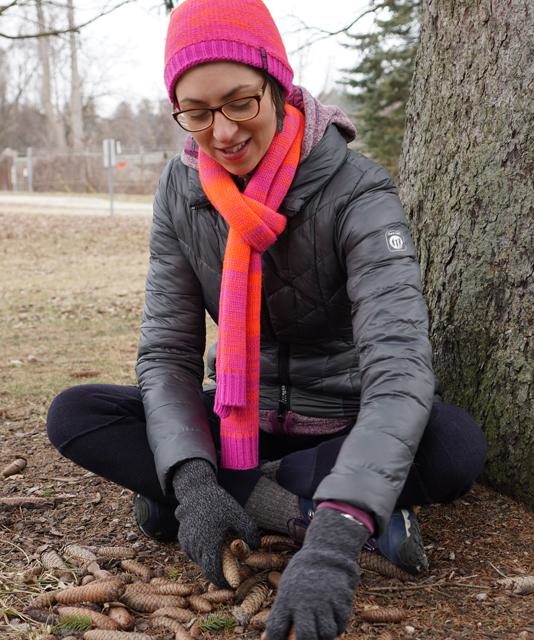It “is not a nature walk,” Cayla Samano tells me when we meet in the snowy, almost deserted parking lot at the Barton Nature Area. “It’s not a hike. It’s really about nature connection.” Then she leads the way into the woods for some “forest therapy.”
Thirty-five, dark-eyed, and heavily layered for the cold, Samano explains that she’ll extend a series of “invitations,” prompts for how I might interact with the environment. But they are “totally modifiable,” she adds. “Change them as you like.”
First, to “wake up our senses,” she tells me to concentrate on each one individually. I close my eyes to concentrate on listening to the sounds around me and even open my mouth to “taste the air.” When I finally reopen my eyes, I discover that what initially felt like an exceedingly dreary day in my least favorite season is suddenly full of surprising life. I tune in to distant birdsong, and I notice how my own body’s movement in the wind mirrors that of the trees surrounding me.
Samano and I take turns describing what we observed, exchanging silent smiles of appreciation. Later, she tells me that she’s seen many different reactions to this first “invitation.” One woman, expecting a more traditional, exercise-oriented nature hike, arrived chatty and energized, and Samano wondered if she would settle into the reflective spirit of forest therapy. After the “wake-up,” Samano says the woman “was in tears.”
“She was like, ‘I just realized I haven’t taken enough time for myself. I used to spend a lot of time outside as a child, and it’s just bringing back all these memories,'” Samano tells me later. “And that’s a really common effect of forest therapy.” But, she adds, it’s “not really my place to say” what her clients need to get out of the experience. “I’m just offering them an opportunity to find it.”
For today’s second invitation, Samano tells me to simply follow her, observing whatever is in motion. She walks very slowly, and again I find myself noticing a plethora of unexpected details: the way little clouds of foam rush down the Huron River and accumulate on its banks after piling up at the base of Barton Dam, the ducks dabbling in the water, the way the trees dance in the wind in the far distance.
Although Samano’s movements are slow, there’s a spring in her step and an air of playfulness. She drops a stick in the river as she crosses a bridge, curiously watching it float away.
—
Forest therapy is based on the Japanese concept of shinrin-yoku, or “forest bathing.” Developed in the early 1980s and based on research that demonstrated physical and mental benefits to mindfully engaging with nature, the concept has recently caught on beyond Japan. “Forest therapy guides” are now certified internationally by the Association of Nature and Forest Therapy (ANFT),
a California-based organization established in 2012.
Samano is southeast Michigan’s only forest therapy guide and one of only five in Michigan. Training is a six-month process, hers began with a weeklong intensive in California. Most of the requirements are completed online, under a mentor, and cover details such as a how to pick a good site (one relatively flat and accessible, biodiverse) and how to prepare tea for the concluding ceremony.
A former art teacher at St. Francis of Assisi Catholic School, Samano has led about 100 forest therapy sessions since 2016. It’s not a living (she charges $30 per person, or $25 per person for groups of ten or more), and neither is the freelance illustration and graphic design work she does on the side. She recently left a job at a nonprofit for more flexible work at Arbor Farms, and plans to return to EMU this fall to complete her MFA. But first, she’s heading to the U.K. this summer to help train forest therapists there.
The outdoors has lured Samano since her childhood in rural North Branch, forty miles northeast of Flint–“the boondocks,” she repeatedly calls it. Growing up with no television and no Internet, she and her four siblings spent a lot of time outside. “It was great,” she says. “It was beautiful. It was clean and pristine.”
When she moved away for college and work, she struggled with a sense of confinement and “feeling less healthy.” In 2015, she ran into an Ohio-based forest therapy guide in a sweat lodge. “The lightbulb went off,” she recalls. “It was like ‘Oh, yeah. This is what I’ve been missing.'”
—
My final invitation is to introduce myself to a tree. “You do that in whatever way feels good to you,” Samano says.
Tamping down my self-consciousness, I lean into the invitation in the most literal way. I walk up to a tall conifer and say, “Hi, I’m Patrick. Who are you?”
Although it should be no surprise given the many unexpected details my heightened watchfulness has revealed today, I’m delighted that the tree becomes somehow more vivid each moment I spend with it. I notice rosy hues in what appeared at first to be dull gray bark and countless holes bored by insects and birds. I look up toward the needles on the high branches, then gaze beyond them, contemplating what the tree has “seen” in its lifetime.
I’m surprised by my reluctance to leave the tree when Samano finally calls me to conclude the session with an abbreviated Japanese tea ceremony. We each drink a small cup of tea and pour one out on the ground as a symbolic thank-you to the forest.
Before we part, Samano presents me with a gift: a small stone she’s decorated with an ink drawing of a lizard on the front and the word “Play” inscribed on the back. The next time I’m out in the woods I think I’ll heed its advice, slow my pace, and just maybe introduce myself to a tree.


